
THE OUR
FREENATURE WINES
“Free Nature” is a project shared by Cravanzola with other wine producers in Castellinaldo d’Alba, putting into practice the strategic idea of entrusting the fate of production more to soil and crop management than to chemistry, and harnessing the seasons and the natural rhythms of biological organisms while safeguarding the fertility of the land.
The project started out with two varietals (Arneis and Barbera) and two vineyards. The challenge is to extend it to all the varieties and eventually throughout the entire estate.
For the time being you can raise your glasses with the white Alseide Langhe bianco and the red Niseo Langhe rosso.


LANGHE WHITE DOC
ALSEIDE®
LANGHE RED DOC
NISèO®


